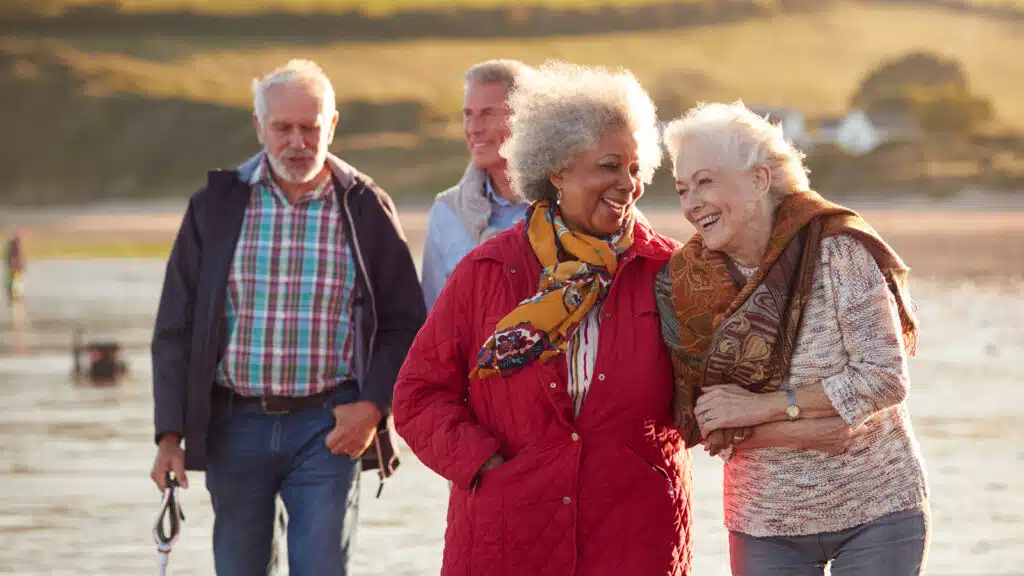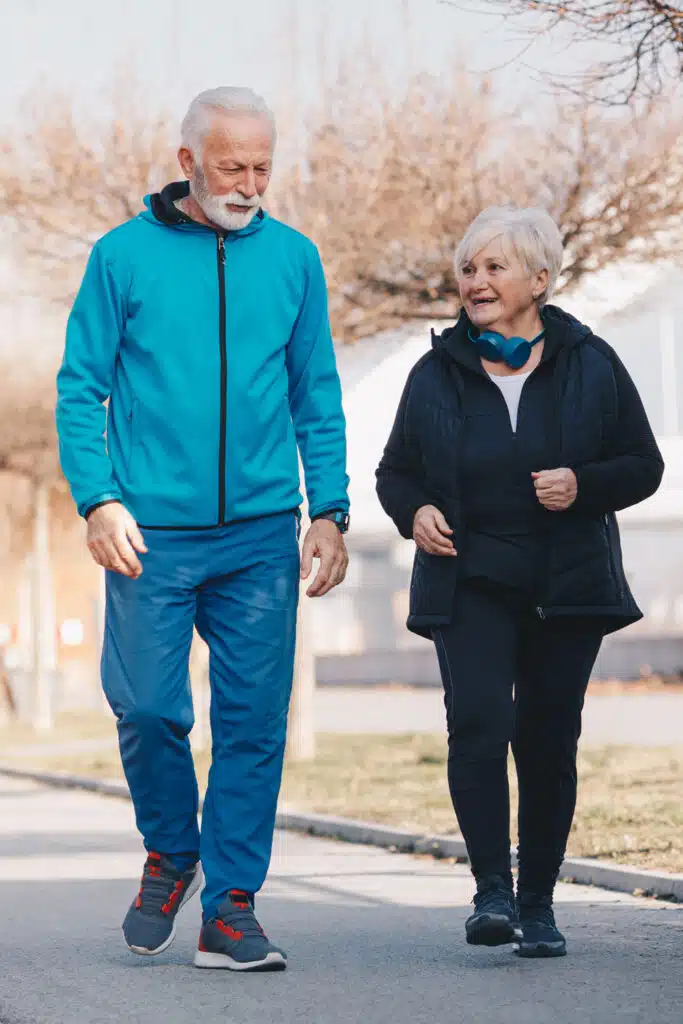You can be a slow walker or enjoy slow walking with purpose – both are beneficial for your health. Walking is good for everyone!
Maybe you’re an older adult or struggle with disabilities. Or maybe you’re carrying excess weight. You can still enjoy all the health benefits of walking – it’s just at a slower pace.
Or maybe you want to try slow walking with purpose – paying attention to your body and surroundings while you walk. In practical terms, this means slowing down your stride so that you can feel where each foot touches the ground and paying attention to how your body moves with each step. If a distraction pops up, take the time to acknowledge it and bring your focus back to the present moment. It’s walking mindfully.

What Is Slow Walking Good For?
Is slow walking good for you? The answer is a resounding yes. Slow walking can burn more calories per mile than walking at a faster pace plus it’s better for your joints if you’re carrying a lot of excess weight.
Don’t be put off walking if your pace is slow! You can still enjoy the remarkable health benefits of walking.
For those who choose to walk mindfully, the physical benefits are clear: better posture, improved balance, and greater ease in your gait. It can also be beneficial for people with chronic pain or limited mobility due to injury or illness.
But the mental health and emotional benefits of mindful slow walking are just as important. It’s a way to reduce stress, improve focus and concentration, and increase feelings of wellbeing. It can even help with creativity! Some people use slow walking as a tool to break out of negative thought patterns.
How Slow Walking Can Burn More Calories Per Mile
It’s all about momentum, the power of being in motion. If you’re walking slowly you’re losing that extra boost to your body movement.
Sadly, the increased cost of total energy expenditure when you walk slowly can put many people off exercising. But persevere and you’ll be burning extra calories per mile.
If you’re carrying excess weight, walking slowly can burn a lot more calories per mile at comparable paces than if you’re a normal weight walker. Find out how many calories you burn per mile using my calories burned walking calculator.
Research by Browning and Kram at the University of Colorado found that obese people were very energy efficient walkers. Their calorie burn per pound over a short distance was similar to calories burned by normal weight walkers and their walking speeds were similar.
Related post: How To Lose Weight Walking 2 Miles A Day

Brisk Walking
Most walking for weight loss plans advocate brisk walking rather than walking at a moderate pace. Your walking speed – brisk, moderate, or slow relates to effort.
Running uses a system called Rating Of Perceived Exertion RPE as a way of recording the intensity of runs. It’s also a helpful way to think about walking.
For a walker, a brisk walk would be an RPE of 4-5 where you can talk as you walk but you’re a little out of breath and you need to work at maintaining your pace.
You may still be walking slowly compared with a fitter or younger walker, but you’re walking quickly compared to your natural walking pace. You’re trying to walk faster and making an effort.
Walking calculators use body weight as a rough guide to calculate calories burned. They fail to take into account the effort of walkers who are normal weight but struggle to walk faster because of age, fitness, or other disabilities.
Your pace may be slow, but you may find that because of the extra effort required, you’re burning more calories than the calculators suggest.
Why Walking Is Good For Your Joints
If you suffer from joint pain or arthritis, don’t stop exercising. Walking helps to keep your joint cartilage healthy and strengthen your muscles – strong muscles help to take some of the weight off your joints.
The American Journal of Preventative Medicine advocates moderate to vigorous exercise at least one hour a week to stay disability-free. Check with your doctor about suitable exercise but the general rule is even if your joints hurt you still need to keep moving!
However, pounding on pavements isn’t the best idea for your joint health, especially for your hips and knee joints. Try walking in local parks on softer ground and use walking poles to reduce the impact on your joints.
Don’t push too hard or too fast. Build up your level and pace of walking slowly and work within the limitations of your body.
How To Walk Mindfully
If you want to walk slowly with purpose, find a place in nature where you’ll be undisturbed. Focus on walking over a short distance.
Before you start, breathe and tune into your body. Walk slowly with purpose by carefully placing each foot and being aware of how your weight transfers from one foot to the other.
Your mind should be absorbed by your walking. Acknowledge distractions and consciously let them go – returning thoughts to your body and the motion of placing one foot down at a time as you walk forward.
When you complete your planned distance take a pause. You can choose to walk back or continue with your day.
I like to incorporate walking mindfully into a regular hike. Try it next time you’re out walking. Take a pause, slow down, and walk a few paces purely thinking about your body and its movement.

Why Do You Walk Slower As You Get Older?
Sometimes it feels like everything gets harder as you get older! But walking more slowly as you age can be explained by loss of muscle strength and mass.
Research recently published in The Journal of Physiology has found that elderly people walk at a slower speed and tire more quickly because of loss of strength and mass in leg muscles.
Often it’s a vicious circle. Older people lose muscle strength and find walking harder – so they walk less leading to more loss of muscle strength.
So even if it feels harder than when you were young, it’s so important to keep walking and exercising as you age.
How Long Should I Walk?
Any movement is better than none. That said, try and hit the recommended guidelines for physical activity of 150 minutes of physical activity at moderate intensity and 2 days of strength training activity for adults every week.
Walking 30 minutes a day is a good target for most people. If you find this difficult – split your walking into 2 or 3 sessions. Maybe walk for 10 minutes in the morning, 10 minutes at lunchtime, and 10 minutes in the evening.
Tips To Get The Most Out Of Walking Slowly
#1 Try Nordic Walking
Walking or fitness poles can be a good way to get more out of your walking. You’ll use your upper body and give your heart rate a boost.
#2 Seek Out Nature
Walking in nature helps with your mental health and walking on footpaths can be easier on your joints.
#3 Walk With Friends
Social interaction is so important and can be neglected as you age. Use walking as a way of staying mobile and catching up with friends. It’s always good to walk and talk!
#4 Look For Variety
Mix things up by seeking out new walking routes. Try walking your normal route in a different direction – it can make such a big difference!
#5 Walk Regularly
It’s regular walking that makes the biggest difference. Aim to walk at least 4 to 5 times a week – every day is best! Set aside time to get out and exercise in your daily routine.
#6 Mix It Up
Try cross-training with other low-impact activities to get more movement in your life. Swimming, aerobic classes, yoga, cycling or even climbing at your local wall are all good ways to exercise.
Related post: 47 Tips For How To Get Fit

Thoughts From Love Life Be Fit
Check-in with your doctor first but just about everyone can benefit from walking – no matter how slowly. Moving more is the best way to avoid disability in later life.
It doesn’t matter how fast you walk relative to other people, it’s just important to make regular walking a part of your life. If all you can manage is 5 minutes a day – it’s still better than nothing. Just try and gradually increase your daily activity.
There are lots of tips on this site to help you start walking. Take the first step here with my post: How To Start A Walking Program For Beginners
